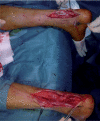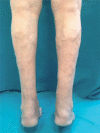Neglected complete bilateral achilles tendon rupture. clinical case presentation, treatment and follow-up
- PMID: 32555094
- PMCID: PMC7944814
- DOI: 10.23750/abm.v91i4-S.9518
Neglected complete bilateral achilles tendon rupture. clinical case presentation, treatment and follow-up
Abstract
Background and aim of the work: subcutaneous Achilles tendon lesions are common degenerative tendon tears, often related to sport activities, multiple pharmacotherapies and internal medical comorbidities. Neglect an Achilles tendon lesion can affect walk ability, while neglect a bilateral lesion could really lead to a serious limitation of self-sufficiency in daily living. We report a case of chronic bilateral Achilles tendon lesion successful treated with LARS augmentation, along with some clinical considerations concerning the clinical outcome.
Methods: we report a case of a chronic bilateral Achilles tendon lesion in an elderly man with multiple comorbidities, successful treated with LARS reconstruction, along with some considerations concerning possible intraoperative issues and the clinical outcome.
Results: good functional result was obtained as documented with pre and postoperative American Orthopedic Foot And Ankle Society Scale and the "Foot And Ankle Disability Index", without complications.
Conclusions: a bilateral Achilles tendon rupture is a very disabling pathology, that needs prompt diagnosis and treatment to prevent further complications. LARS reconstruction could be an effective method in selected patients to avoid some intraoperative issues related to patient comorbidities and ability to follow complex postoperative rehabilitation protocols. (www.actabiomedica.it).
Conflict of interest statement
Each author declares that he or she has no commercial associations (e.g. consultancies, stock ownership, equity interest, patent/licensing arrangement etc.) that might pose a conflict of interest in connection with the submitted article
Figures





Similar articles
-
V-Y Tendon Plasty for Reconstruction of Chronic Achilles Tendon Rupture: A Medium-term and Long-term Follow-up.Orthop Surg. 2019 Feb;11(1):109-116. doi: 10.1111/os.12429. Epub 2019 Feb 27. Orthop Surg. 2019. PMID: 30809943 Free PMC article.
-
Percutaneous, Minimally Invasive Repair of Traumatic and Simultaneous Rupture of Both Achilles Tendons: A Case Report.J Foot Ankle Surg. 2016 May-Jun;55(3):642-4. doi: 10.1053/j.jfas.2015.03.005. Epub 2015 May 20. J Foot Ankle Surg. 2016. PMID: 26002678
-
[The reconstruction of Myerson type Ⅲ chronic Achilles tendon rupture by using the total arthroscopic technique combined with free semitendinosus tendon and gracilis tendon autograft].Zhonghua Wai Ke Za Zhi. 2020 Sep 1;58(9):718-722. doi: 10.3760/cma.j.cn112139-20200306-00194. Zhonghua Wai Ke Za Zhi. 2020. PMID: 32878420 Chinese.
-
Tendon disorders of the foot and ankle, part 2: achilles tendon disorders.Am J Sports Med. 2009 Jun;37(6):1223-34. doi: 10.1177/0363546509335947. Epub 2009 May 5. Am J Sports Med. 2009. PMID: 19417123 Review.
-
Treatment of the neglected Achilles tendon rupture.Clin Podiatr Med Surg. 2012 Apr;29(2):291-9, viii. doi: 10.1016/j.cpm.2012.01.004. Epub 2012 Feb 15. Clin Podiatr Med Surg. 2012. PMID: 22424489 Review.
References
-
- Hess G.W. Achilles tendon rupture: a review of etiology, population, anatomy, risk factors, and injury prevention. Foot ankle spec. 2010;3(1):29–32. - PubMed
-
- Matsumoto K, Hukuda S, Nishioka J, Asajima S. Rupture of the Achilles tendon in rheumatoid arthritis with histologic evidence of enthesitis. A case report. Clin. Orthop. Relat. Res. 1992;280:235–240. - PubMed
-
- Vosseller J.T, Ellis S.J, Levine D.S, et al. Achilles tendon rupture in women. Foot Ankle int. 2013;34(1):49–53. - PubMed
-
- Cary D.V. How to diagnose and manage an acute Achilles tendon rupture. JAAPA-J AM ACAD PHYS. 2009;22(8):39–43. - PubMed
Publication types
MeSH terms
LinkOut - more resources
Full Text Sources
Research Materials

